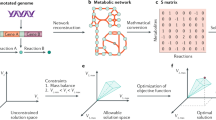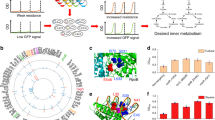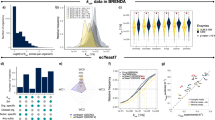Abstract
The number and scope of methods developed to interrogate and use metabolic network reconstructions has significantly expanded over the past 15 years. In particular, Escherichia coli metabolic network reconstruction has reached the genome scale and been utilized to address a broad spectrum of basic and practical applications in five main categories: metabolic engineering, model-directed discovery, interpretations of phenotypic screens, analysis of network properties and studies of evolutionary processes. Spurred on by these accomplishments, the field is expected to move forward and further broaden the scope and content of network reconstructions, develop new and novel in silico analysis tools, and expand in adaptation to uses of proximal and distal causation in biology. Taken together, these efforts will solidify a mechanistic genotype-phenotype relationship for microbial metabolism.
This is a preview of subscription content, access via your institution
Access options
Subscribe to this journal
Receive 12 print issues and online access
$209.00 per year
only $17.42 per issue
Buy this article
- Purchase on Springer Link
- Instant access to full article PDF
Prices may be subject to local taxes which are calculated during checkout





Similar content being viewed by others
References
Reed, J.L., Famili, I., Thiele, I. & Palsson, B.O. Towards multidimensional genome annotation. Nat. Rev. Genet. 7, 130–141 (2006).
Palsson, B.Ø. Systems Biology: Properties Of Reconstructed Networks. (Cambridge University Press, New York; 2006).
Price, N.D., Reed, J.L. & Palsson, B.O. Genome-scale models of microbial cells: evaluating the consequences of constraints. Nat. Rev. Microbiol. 2, 886–897 (2004).
Frazier, M.E., Johnson, G.M., Thomassen, D.G., Oliver, C.E. & Patrinos, A. Realizing the potential of the Genome Revolution: The Genomes to life Program. Science 300, 290–293 (2003).
Reed, J.L. & Palsson, B.Ø. Thirteen years of building constraint-based in silico models of Escherichia coli. J. Bacteriol. 185, 2692–2699 (2003).
Becker, S.A. et al. Quantitative prediction of cellular metabolism with constraint-based models: The COBRA Toolbox. Nat. Protoc. 2, 727–738 (2007).
Lee, S.Y. et al. Systems-level analysis of genome-scale in silico metabolic models using MetaFluxNet. Biotechnol. Bioproc. Eng. 10, 425–431 (2005).
Klamt, S., Saez-Rodriguez, J. & Gilles, E.D. Structural and functional analysis of cellular networks with CellNetAnalyzer. BMC Syst. Biol. 1, 2 (2007).
Raman, K. and Chandra, N. PathwayAnalyser: a systems biology tool for flux analysis of metabolic pathways. Available from Nature Precedings <http://dx.doi.org/10.1038/npre.2008.1868.1> (2008).
Luo, R.Y., Liao, S., Zeng, S.Q., Li, Y.X. & Luo, Q.M. FluxExplorer: A general platform for modeling and analyses of metabolic networks based on stoichiometry. Chin. Sci. Bull. 51, 689–696 (2006).
Hucka, M. et al. The systems biology markup language (SBML): a medium for representation and exchange of biochemical network models. Bioinformatics 19, 524–531 (2003).
Majewski, R.A. & Domach, M.M. Simple constrained optimization view of acetate overflow in E. coli. Biotechnol. Bioeng. 35, 732–738 (1990).
Varma, A., Boesch, B.W. & Palsson, B.Ø. Stoichiometric interpretation of Escherichia coli glucose catabolism under various oxygenation rates. Appl. Environ. Microbiol. 59, 2465–2473 (1993).
Varma, A., Boesch, B.W. & Palsson, B.Ø. Biochemical production capabilities of Escherichia coli. Biotechnol. Bioeng. 42, 59–73 (1993).
Pramanik, J. & Keasling, J.D. Stoichiometric model of Escherichia coli metabolism: Incorporation of growth-rate dependent biomass composition and mechanistic energy requirements. Biotechnol. Bioeng. 56, 398–421 (1997).
Pramanik, J. & Keasling, J.D. Effect of Escherichia coli biomass composition on central metabolic fluxes predicted by a stoichiometric model. Biotechnol. Bioeng. 60, 230–238 (1998).
Reed, J.L., Vo, T.D., Schilling, C.H. & Palsson, B.Ø. An expanded genome-scale model of Escherichia coli K-12 (iJR904 GSM/GPR). Genome Biology 4, R54.51–R54.12 (2003).
Edwards, J.S. & Palsson, B.O. The Escherichia coli MG1655 in silico metabolic genotype: Its definition, characteristics, and capabilities. Proc. Natl. Acad. Sci. USA 97, 5528–5533 (2000).
Feist, A.M. et al. A genome-scale metabolic reconstruction for Escherichia coli K-12 MG1655 that accounts for 1260 ORFs and thermodynamic information. Mol. Syst. Biol. 3, 121 (2007).
Burgard, A.P., Pharkya, P. & Maranas, C.D. Optknock: a bilevel programming framework for identifying gene knockout strategies for microbial strain optimization. Biotechnol. Bioeng. 84, 647–657 (2003).
Pharkya, P., Burgard, A.P. & Maranas, C.D. Exploring the overproduction of amino acids using the bilevel optimization framework OptKnock. Biotechnol. Bioeng. 84, 887–899 (2003).
Pharkya, P., Burgard, A.P. & Maranas, C.D. OptStrain: a computational framework for redesign of microbial production systems. Genome Res. 14, 2367–2376 (2004).
Alper, H., Jin, Y.S., Moxley, J.F. & Stephanopoulos, G. Identifying gene targets for the metabolic engineering of lycopene biosynthesis in Escherichia coli. Metab. Eng. 7, 155–164 (2005).
Alper, H., Miyaoku, K. & Stephanopoulos, G. Construction of lycopene-overproducing E. coli strains by combining systematic and combinatorial gene knockout targets. Nat. Biotechnol. 23, 612–616 (2005).
Fong, S.S. et al. In silico design and adaptive evolution of Escherichia coli for production of lactic acid. Biotechnol. Bioeng. 91, 643–648 (2005).
Pharkya, P. & Maranas, C.D. An optimization framework for identifying reaction activation/inhibition or elimination candidates for overproduction in microbial systems. Metab. Eng. 8, 1–13 (2006).
Lee, S.J. et al. Metabolic engineering of Escherichia coli for enhanced production of succinic acid, based on genome comparison and in silico gene knockout simulation. Appl. Environ. Microbiol. 71, 7880–7887 (2005).
Wang, Q., Chen, X., Yang, Y. & Zhao, X. Genome-scale in silico aided metabolic analysis and flux comparisons of Escherichia coli to improve succinate production. Appl. Microbiol. Biotechnol. 73, 887–894 (2006).
Park, J.H., Lee, K.H., Kim, T.Y. & Lee, S.Y. Metabolic engineering of Escherichia coli for the production of L-valine based on transcriptome analysis and in silico gene knockout simulation. Proc. Natl. Acad. Sci. USA 104, 7797–7802 (2007).
Lee, K.H., Park, J.H., Kim, T.Y., Kim, H.U. & Lee, S.Y. Systems metabolic engineering of Escherichia coli for L-threonine production. Mol. Syst. Biol. 3, 149 (2007).
Covert, M.W., Knight, E.M., Reed, J.L., Herrgard, M.J. & Palsson, B.Ø. Integrating high-throughput and computational data elucidates bacterial networks. Nature 429, 92–96 (2004).
Chen, L. & Vitkup, D. Predicting genes for orphan metabolic activities using phylogenetic profiles. Genome Biol. 7, R17 (2006).
Kharchenko, P., Chen, L., Freund, Y., Vitkup, D. & Church, G.M. Identifying metabolic enzymes with multiple types of association evidence. BMC Bioinformatics 7, 117 (2006).
Herrgard, M.J., Fong, S.S. & Palsson, B.Ø. Identification of genome-scale metabolic network models using experimentally measured flux profiles. PLoS Comput. Biol. 2, e72 (2006).
Reed, J.L. et al. Systems approach to refining genome annotation. Proc. Natl. Acad. Sci. USA 103, 17480–17484 (2006).
Satish Kumar, V., Dasika, M.S. & Maranas, C.D. Optimization based automated curation of metabolic reconstructions. BMC Bioinformatics 8, 212 (2007).
Fuhrer, T., Chen, L., Sauer, U. & Vitkup, D. Computational prediction and experimental verification of the gene encoding the NAD+/NADP+-dependent succinate semialdehyde dehydrogenase in Escherichia coli. J. Bacteriol. 189, 8073–8079 (2007).
Edwards, J.S., Ibarra, R.U. & Palsson, B.Ø. In silico predictions of Escherichia coli metabolic capabilities are consistent with experimental data. Nat. Biotechnol. 19, 125–130 (2001).
Burgard, A.P., Vaidyaraman, S. & Maranas, C.D. Minimal reaction sets for Escherichia coli metabolism under different growth requirements and uptake environments. Biotechnol. Prog. 17, 791–797 (2001).
Beard, D.A., Liang, S.D. & Qian, H. Energy balance for analysis of complex metabolic networks. Biophys. J. 83, 79–86 (2002).
Segre, D., Vitkup, D. & Church, G.M. Analysis of optimality in natural and perturbed metabolic networks. Proc. Natl. Acad. Sci. USA 99, 15112–15117 (2002).
Ibarra, R.U., Edwards, J.S. & Palsson, B.Ø. Escherichia coli K-12 undergoes adaptive evolution to achieve in silico predicted optimal growth. Nature 420, 186–189 (2002).
Fong, S.S. & Palsson, B.Ø. Metabolic gene-deletion strains of Escherichia coli evolve to computationally predicted growth phenotypes. Nat. Genet. 36, 1056–1058 (2004).
Imielinski, M., Belta, C., Halasz, A. & Rubin, H. Investigating metabolite essentiality through genome-scale analysis of Escherichia coli production capabilities. Bioinformatics 21, 2008–2016 (2005).
Shlomi, T., Berkman, O. & Ruppin, E. Regulatory on/off minimization of metabolic flux changes after genetic perturbations. Proc. Natl. Acad. Sci. USA 102, 7695–7700 (2005).
Ghim, C.M., Goh, K.I. & Kahng, B. Lethality and synthetic lethality in the genome-wide metabolic network of Escherichia coli. J. Theor. Biol. 237, 401–411 (2005).
Henry, C.S., Jankowski, M.D., Broadbelt, L.J. & Hatzimanikatis, V. Genome-scale thermodynamic analysis of Escherichia coli metabolism. Biophys. J. 90, 1453–1461 (2006).
Samal, A. et al. Low degree metabolites explain essential reactions and enhance modularity in biological networks. BMC Bioinformatics 7, 118 (2006).
Kümmel, A., Panke, S. & Heinemann, M. Putative regulatory sites unraveled by network-embedded thermodynamic analysis of metabolome data. Mol. Syst. Biol. 2, 2006.0034 (2006).
Wunderlich, Z. & Mirny, L.A. Using the topology of metabolic networks to predict viability of mutant strains. Biophys. J. 91, 2304–2311 (2006).
Gerdes, S. et al. Essential genes on metabolic maps. Curr. Opin. Biotechnol. 17, 448–456 (2006).
Kümmel, A., Panke, S. & Heinemann, M. Systematic assignment of thermodynamic constraints in metabolic network models. BMC Bioinformatics 7, 512 (2006).
Joyce, A.R. et al. Experimental and computational assessment of conditionally essential genes in Escherichia coli. J. Bacteriol. 188, 8259–8271 (2006).
Henry, C.S., Broadbelt, L.J. & Hatzimanikatis, V. Thermodynamics-based metabolic flux analysis. Biophys. J. 92, 1792–1805 (2007).
Ederer, M. & Gilles, E.D. Thermodynamically feasible kinetic models of reaction networks. Biophys. J. 92, 1846–1857 (2007).
Choi, H.S., Kim, T.Y., Lee, D.Y. & Lee, S.Y. Incorporating metabolic flux ratios into constraint-based flux analysis by using artificial metabolites and converging ratio determinants. J. Biotechnol. 129, 696–705 (2007).
Hoppe, A., Hoffmann, S. & Holzhutter, H.G. Including metabolite concentrations into flux balance analysis: thermodynamic realizability as a constraint on flux distributions in metabolic networks. BMC Syst. Biol. 1, 23 (2007).
Guimera, R., Sales-Pardo, M. & Amaral, L.A. A network-based method for target selection in metabolic networks. Bioinformatics 23, 1616–1622 (2007).
Beg, Q.K. et al. Intracellular crowding defines the mode and sequence of substrate uptake by Escherichia coli and constrains its metabolic activity. Proc. Natl. Acad. Sci. USA 104, 12663–12668 (2007).
Kim, P.J. et al. Metabolite essentiality elucidates robustness of Escherichia coli metabolism. Proc. Natl. Acad. Sci. USA 104, 13638–13642 (2007).
Warren, P.B. & Jones, J.L. Duality, thermodynamics, and the linear programming problem in constraint-based models of metabolism. Phys. Rev. Lett. 99, 108101 (2007).
Vazquez, A. et al. Impact of the solvent capacity constraint on E. coli metabolism. BMC Syst. Biol. 2, 7 (2008).
Motter, A.E., Gulbahce, N., Almaas, E. & Barabasi, A.L. Predicting synthetic rescues in metabolic networks. Mol. Syst. Biol. 4, 168 (2008).
Gagneur, J., Jackson, D.B. & Casari, G. Hierarchical analysis of dependency in metabolic networks. Bioinformatics 19, 1027–1034 (2003).
Mahadevan, R. & Schilling, C.H. The effects of alternate optimal solutions in constraint-based genome-scale metabolic models. Metab. Eng. 5, 264–276 (2003).
Burgard, A.P., Nikolaev, E.V., Schilling, C.H. & Maranas, C.D. Flux coupling analysis of genome-scale metabolic network reconstructions. Genome Res. 14, 301–312 (2004).
Almaas, E., Kovacs, B., Vicsek, T., Oltvai, Z.N. & Barabasi, A.L. Global organization of metabolic fluxes in the bacterium Escherichia coli. Nature 427, 839–843 (2004).
Nikolaev, E.V., Burgard, A.P. & Maranas, C.D. Elucidation and structural analysis of conserved pools for genome-scale metabolic reconstructions. Biophys. J. 88, 37–49 (2005).
Almaas, E., Oltvai, Z.N. & Barabasi, A.L. The activity reaction core and plasticity of metabolic networks. PLoS Comput. Biol. 1, e68 (2005).
Barrett, C.L., Herring, C.D., Reed, J.L. & Palsson, B.O. The global transcriptional regulatory network for metabolism in Escherichia coli attains few dominant functional states. Proc. Natl. Acad. Sci. USA 102, 19103–19108 (2005).
Becker, S.A., Price, N.D. & Palsson, B.O. Metabolite coupling in genome-scale metabolic networks. BMC Bioinformatics 7, 111 (2006).
Imielinski, M., Belta, C., Rubin, H. & Halasz, A. Systematic analysis of conservation relations in Escherichia coli genome-scale metabolic network reveals novel growth media. Biophys. J. 90, 2659–2672 (2006).
Beasley, J.E. & Planes, F.J. Recovering metabolic pathways via optimization. Bioinformatics 23, 92–98 (2007).
Shlomi, T., Eisenberg, Y., Sharan, R. & Ruppin, E. A genome-scale computational study of the interplay between transcriptional regulation and metabolism. Mol. Syst. Biol. 3, 101 (2007).
Almaas, E. Optimal flux patterns in cellular metabolic networks. Chaos (Woodbury, N.Y.) 17, 026107 (2007).
Sales-Pardo, M., Guimera, R., Moreira, A.A. & Amaral, L.A. Extracting the hierarchical organization of complex systems. Proc. Natl. Acad. Sci. USA 104, 15224–15229 (2007).
Notebaart, R.A., Teusink, B., Siezen, R.J. & Papp, B. Co-regulation of metabolic genes is better explained by flux coupling than by network distance. PLoS Comput. Biol. 4, e26 (2008).
Mahadevan, R. & Lovley, D.R. The degree of redundancy in metabolic genes is linked to mode of metabolism. Biophys. J. 94, 1216–1220 (2008).
Samal, A. & Jain, S. The regulatory network of E. coli metabolism as a Boolean dynamical system exhibits both homeostasis and flexibility of response. BMC Syst. Biol. 2, 21 (2008).
Pal, C., Papp, B. & Lercher, M.J. Horizontal gene transfer depends on gene content of the host. Bioinformatics 21 Suppl 2, ii222–ii223 (2005).
Pal, C., Papp, B. & Lercher, M.J. Adaptive evolution of bacterial metabolic networks by horizontal gene transfer. Nat. Genet. 37, 1372–1375 (2005).
Pal, C. et al. Chance and necessity in the evolution of minimal metabolic networks. Nature 440, 667–670 (2006).
Schuetz, R., Kuepfer, L. & Sauer, U. Systematic evaluation of objective functions for predicting intracellular fluxes in Escherichia coli. Mol. Syst. Biol. 3, 119 (2007).
Varma, A. & Palsson, B.Ø. Metabolic flux balancing: basic concepts, scientific and practical use. Nat. Biotechnol. 12, 994–998 (1994).
Edwards, J.S., Ramakrishna, R., Schilling, C.H. & Palsson, B.Ø. Metabolic flux balance analysis. in Metabolic Engineering (eds. Lee, S.Y. & Papoutsakis, E.T.) (Marcel Dekker, New York, 1999).
Kauffman, K.J., Prakash, P. & Edwards, J.S. Advances in flux balance analysis. Curr. Opin. Biotechnol. 14, 491–496 (2003).
Fraser-Liggett, C.M. Insights on biology and evolution from microbial genome sequencing. Genome Res. 15, 1603–1610 (2005).
Bro, C., Regenberg, B., Forster, J. & Nielsen, J. In silico aided metabolic engineering of Saccharomyces cerevisiae for improved bioethanol production. Metab. Eng. 8, 102–111 (2006).
Mahadevan, R. et al. Characterization of metabolism in the Fe(iii)-reducing organism Geobacter sulfurreducens by constraint-based modeling. Appl. Environ. Microbiol. 72, 1558–1568 (2006).
Feist, A.M., Scholten, J.C.M., Palsson, B. Ø., Brockman, F.J. & Ideker, T. Modeling methanogenesis with a genome-scale metabolic reconstruction of Methanosarcina barkeri. Mol. Syst. Biol. 2, 1–14 (2006).
Breitling, R., Vitkup, D. & Barrett, M.P. New surveyor tools for charting microbial metabolic maps. Nat. Rev. Microbiol. 6, 156–161 (2008).
Blattner, F.R. et al. The complete genome sequence of Escherichia coli K-12. Science 277, 1453–1474 (1997).
Kharchenko, P., Vitkup, D. & Church, G.M. Filling gaps in a metabolic network using expression information. Bioinformatics 20 Suppl 1, I178–I185 (2004).
Green, M.L. & Karp, P.D. A Bayesian method for identifying missing enzymes in predicted metabolic pathway databases. BMC Bioinformatics 5, 76 (2004).
Baba, T. et al. Construction of Escherichia coli K-12 in-frame, single-gene knockout mutants: the Keio collection. Mol. Syst. Biol. 2, 2006.0008 (2006).
Mayr, E. This is Biology: the Science of the Living World. (Belknap Press of Harvard University Press, Cambridge, MA; 1997).
Suthers, P.F. et al. Metabolic flux elucidation for large-scale models using 13C labeled isotopes. Metab. Eng. 9, 387–405 (2007).
Janssen, P., Goldovsky, L., Kunin, V., Darzentas, N. & Ouzounis, C.A. Genome coverage, literally speaking. The challenge of annotating 200 genomes with 4 million publications. EMBO Rep. 6, 397–399 (2005).
Riley, M. et al. Escherichia coli K-12: a cooperatively developed annotation snapshot-2005. Nucleic Acids Res. 34, 1–9 (2006).
Allen, T.E. & Palsson, B.Ø. Sequenced-based analysis of metabolic demands for protein synthesis in prokaryotes. J. Theor. Biol. 220, 1–18 (2003).
Mehra, A. & Hatzimanikatis, V. An algorithmic framework for genome-wide modeling and analysis of translation networks. Biophys. J. 90, 1136–1146 (2006).
Thomas, R., Paredes, C.J., Mehrotra, S., Hatzimanikatis, V. & Papoutsakis, E.T. A model-based optimization framework for the inference of regulatory interactions using time-course DNA microarray expression data. BMC Bioinformatics 8, 228 (2007).
Lee, T.I. et al. Transcriptional regulatory networks in Saccharomyces cerevisiae. Science 298, 799–804 (2002).
Gianchandani, E.P., Papin, J.A., Price, N.D., Joyce, A.R. & Palsson, B.Ø. Matrix formalism to describe functional states of transcriptional regulatory systems. PLoS Comput. Biol. 2, e101 (2006).
Li, C. et al. Computational discovery of biochemical routes to specialty chemicals. Chem. Eng. Sci. 59, 5051–5060 (2004).
Edwards, J.S., Ramakrishna, R. & Palsson, B.Ø. Characterizing the metabolic phenotype: a phenotype phase plane analysis. Biotechnol. Bioeng. 77, 27–36 (2002).
Schuster, S. & Hilgetag, C. On elementary flux modes in biochemical reaction systems at steady state. J. Biol. Syst. 2, 165–182 (1994).
Schilling, C.H., Letscher, D. & Palsson, B.Ø. Theory for the systemic definition of metabolic pathways and their use in interpreting metabolic function from a pathway-oriented perspective. J. Theor. Biol. 203, 229–248 (2000).
Acknowledgements
We would like to thank Andrew Joyce, Jennifer Reed, Daniel Segre, Nathan Price, Markus Herrgard and Christian Barrett for their invaluable insight. A.M.F. is supported by National Institutes of Health R01 GM057089 grant.
Author information
Authors and Affiliations
Corresponding author
Supplementary information
Supplementary Text and Figures
Supplementary Table 1 (PDF 65 kb)
Rights and permissions
About this article
Cite this article
Feist, A., Palsson, B. The growing scope of applications of genome-scale metabolic reconstructions using Escherichia coli. Nat Biotechnol 26, 659–667 (2008). https://doi.org/10.1038/nbt1401
Published:
Issue Date:
DOI: https://doi.org/10.1038/nbt1401
This article is cited by
-
Advances and applications of machine learning and intelligent optimization algorithms in genome-scale metabolic network models
Systems Microbiology and Biomanufacturing (2023)
-
Bottom-up synthetic ecology study of microbial consortia to enhance lignocellulose bioconversion
Biotechnology for Biofuels and Bioproducts (2022)
-
Towards Engineering an Ecosystem: A Review of Computational Approaches to Explore and Exploit the Human Microbiome for Healthcare
Transactions of the Indian National Academy of Engineering (2022)
-
Metabolic modeling predicts specific gut bacteria as key determinants for Candida albicans colonization levels
The ISME Journal (2021)
-
Genomic sequencing, genome-scale metabolic network reconstruction, and in silico flux analysis of the grape endophytic fungus Alternaria sp. MG1
Microbial Cell Factories (2019)



